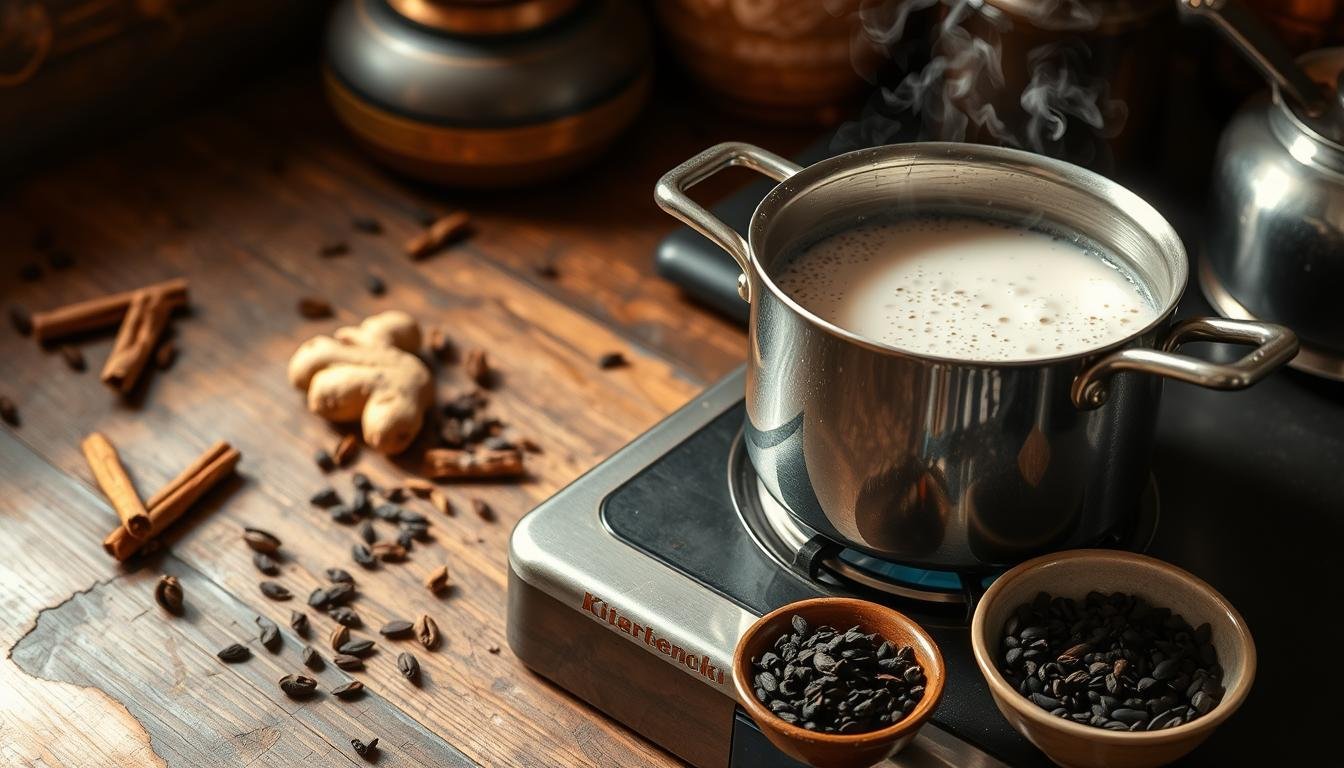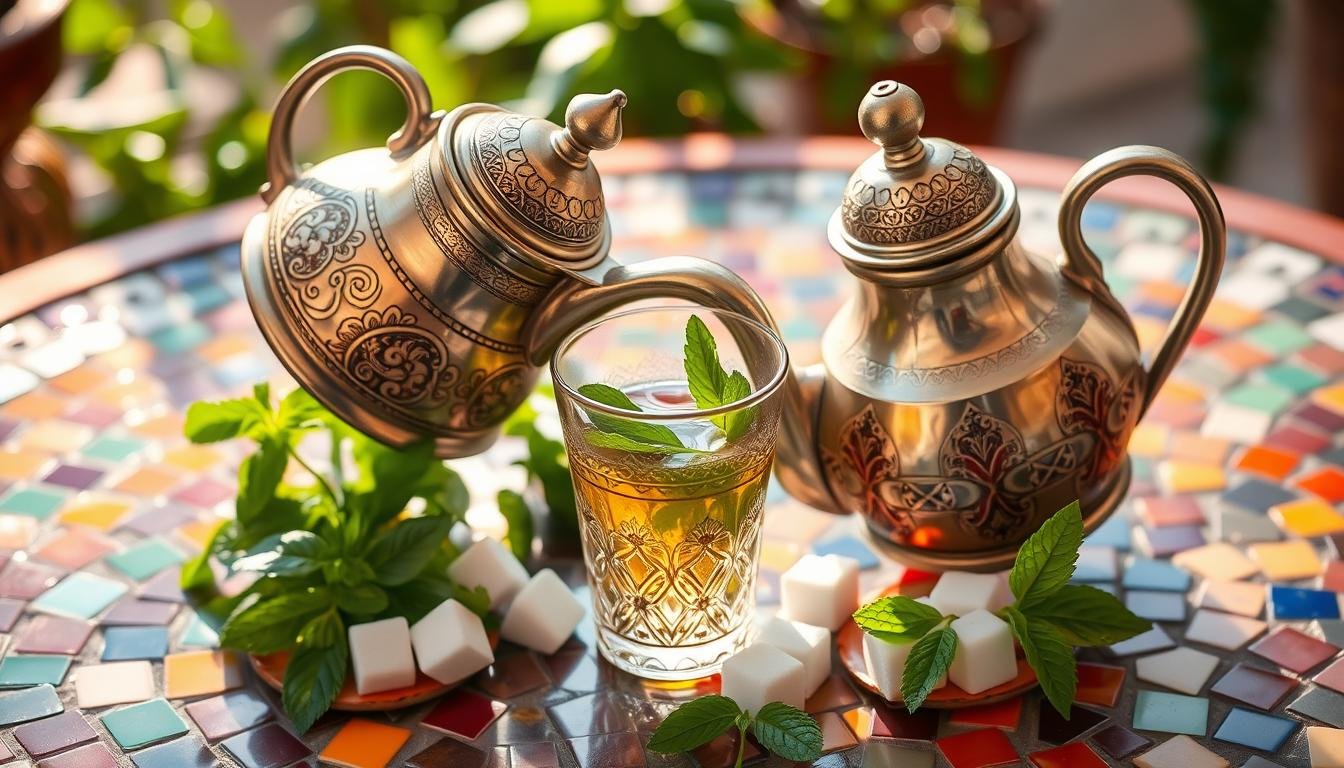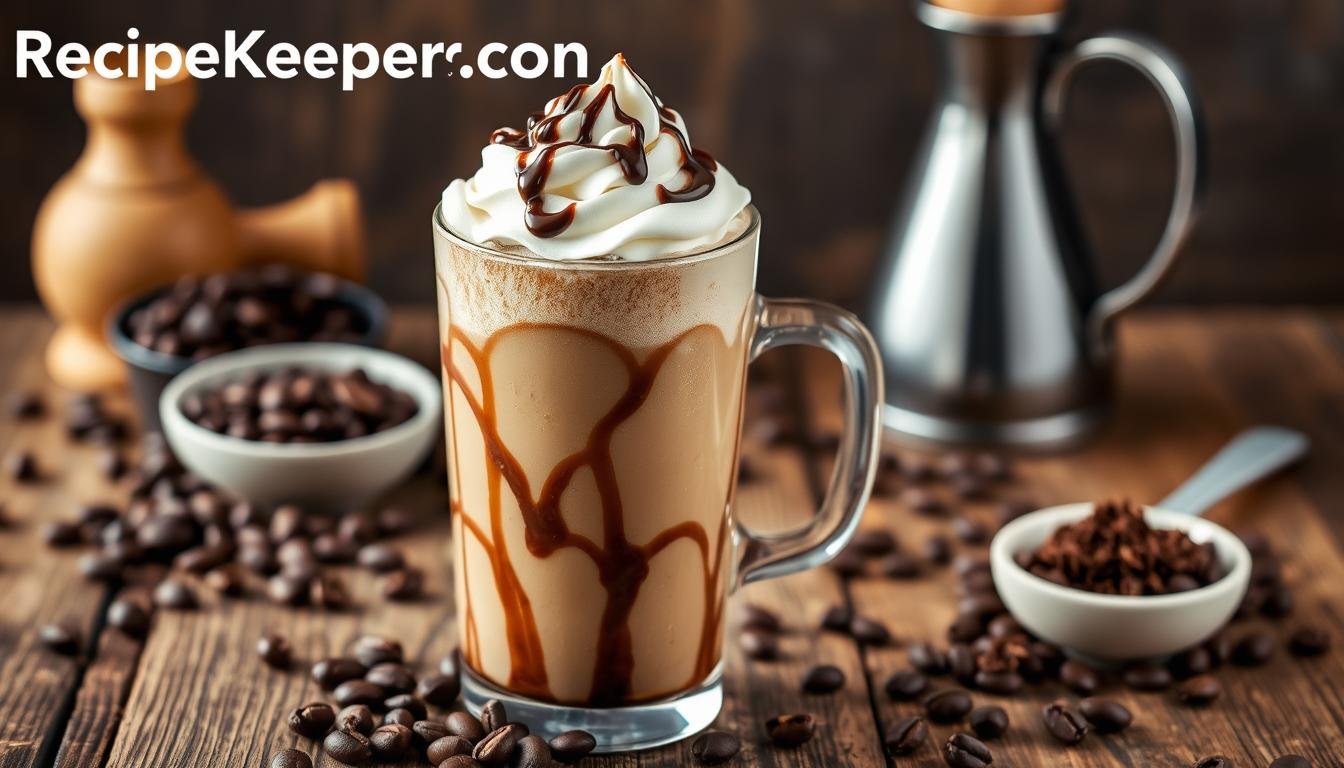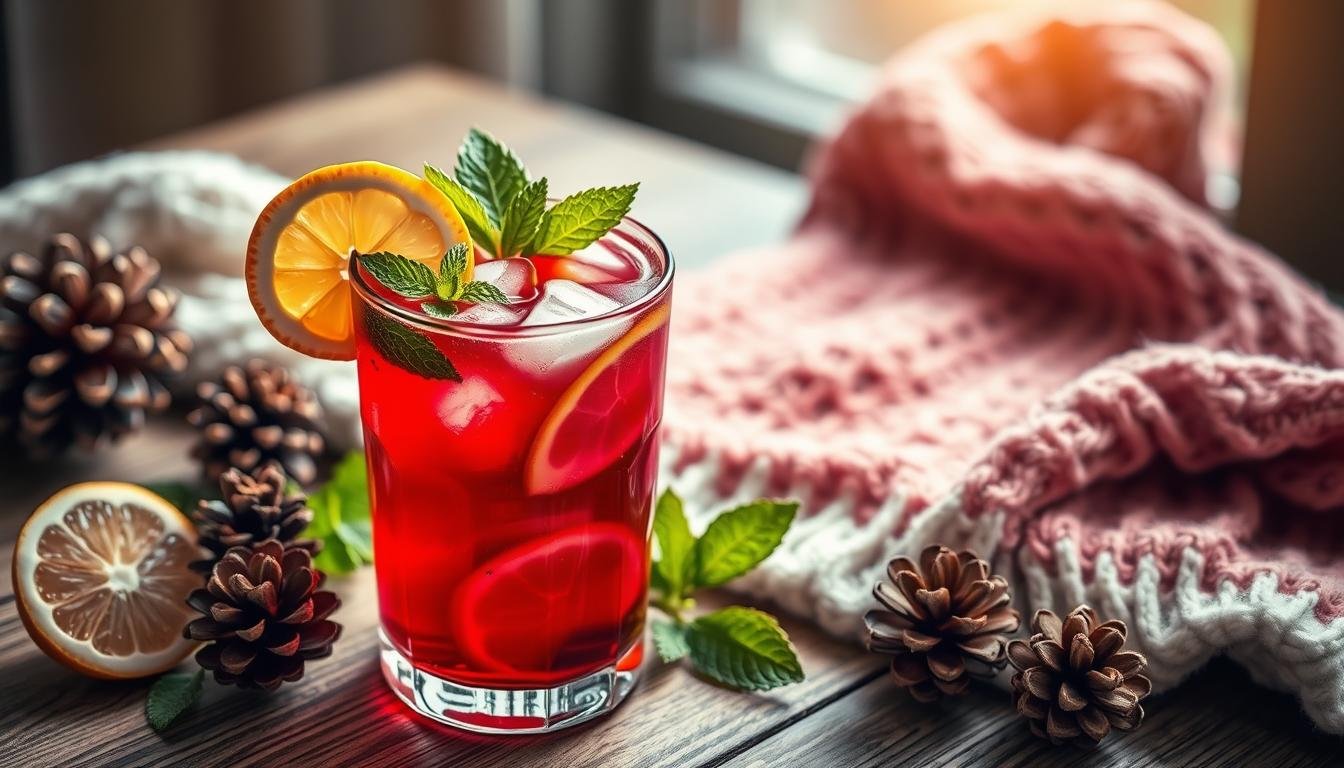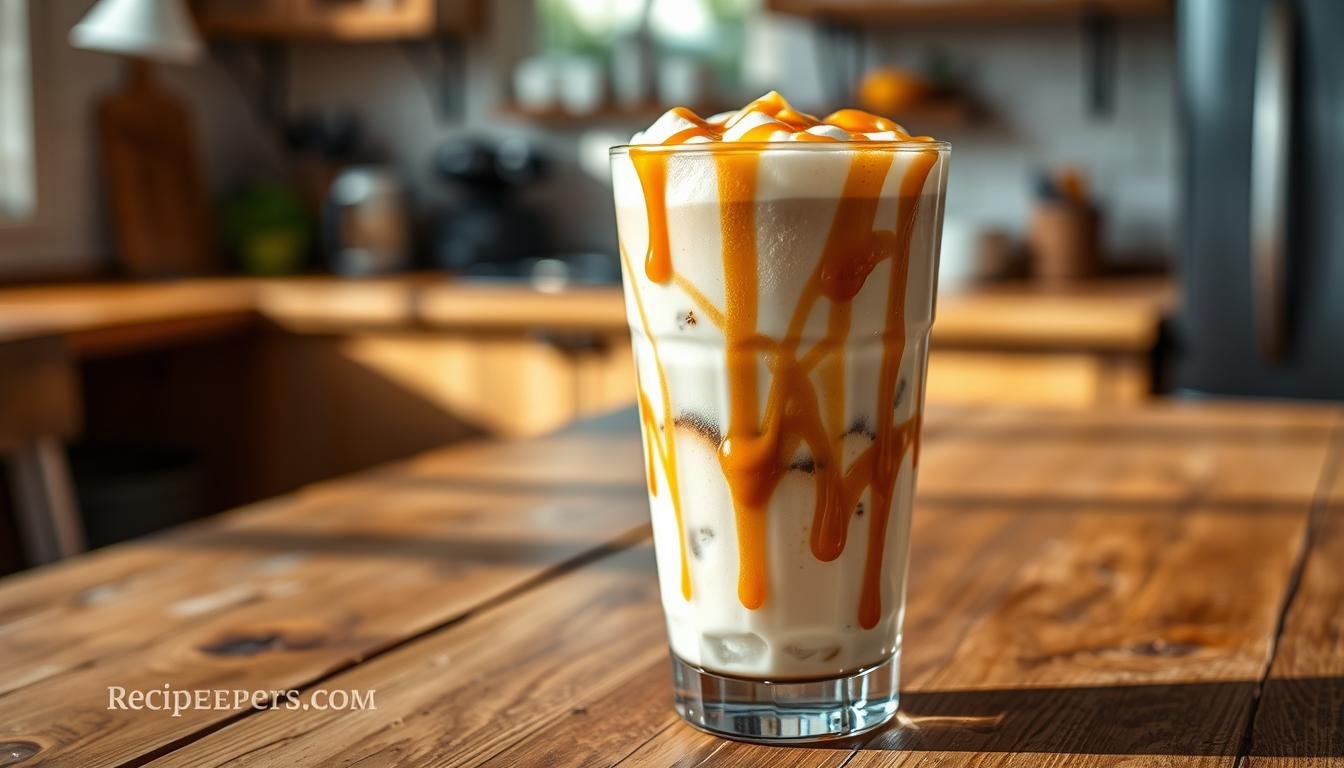Traditional chai tea is more than a drink; it’s a cultural journey through India’s rich heritage. The Indian spiced tea has won hearts globally, moving from a local favorite to a worldwide hit.
Masala Chai’s story began during British rule, growing from a simple tea to a complex, aromatic mix. This drink has been passed down through generations, with about 60% of Indian families making their own special recipe.
Picture a warm cup of chai, blending strong black tea with spices like green cardamom, cinnamon, and ginger. Each region in India adds its own flavor, making a diverse flavor landscape that changes every 100 kilometers.
Key Takeaways
- Masala Chai has roots dating back to the 12th century
- Spices are crucial to creating authentic flavor profiles
- Each Indian family typically has a unique chai recipe
- The drink represents more than just a beverage – it’s a cultural experience
- Cardamom remains one of the most expensive spices used in chai
Understanding the Rich Heritage of Masala Chai
Masala chai is more than a drink; it’s a journey into Indian tradition. Our authentic chai blend connects generations through a simple yet extraordinary drink. Almost 80% of Indian homes enjoy chai every day, making it more than just a refreshment.
The history of this beloved drink goes back to British colonial India. Tea cultivation changed the social and economic scene. Our homemade chai recipe whispers of those moments, blending colonial and Indian traditions.
Origins in British Colonial India
In British colonial India, tea plantations spread, especially in Assam. Tea became a key commodity, with over 100,000 tea estates and millions employed. Today, 70% of India’s tea is enjoyed at home, showing its deep cultural bond.
Cultural Significance in Indian Society
- Chai represents hospitality and social connection
- Serves as a daily ritual in most Indian households
- Brings families and communities together
Evolution into a Global Beverage
In the U.S., masala chai’s popularity has grown by over 30% each year. People are looking for authentic cultural experiences. About 50% of chai lovers in America use family recipes, showing its strong appeal.
Masala chai has won hearts from India’s street markets to global cafes. It tells stories of cultural heritage, one delicious cup at a time.
Essential Ingredients for Perfect Classic Masala Chai
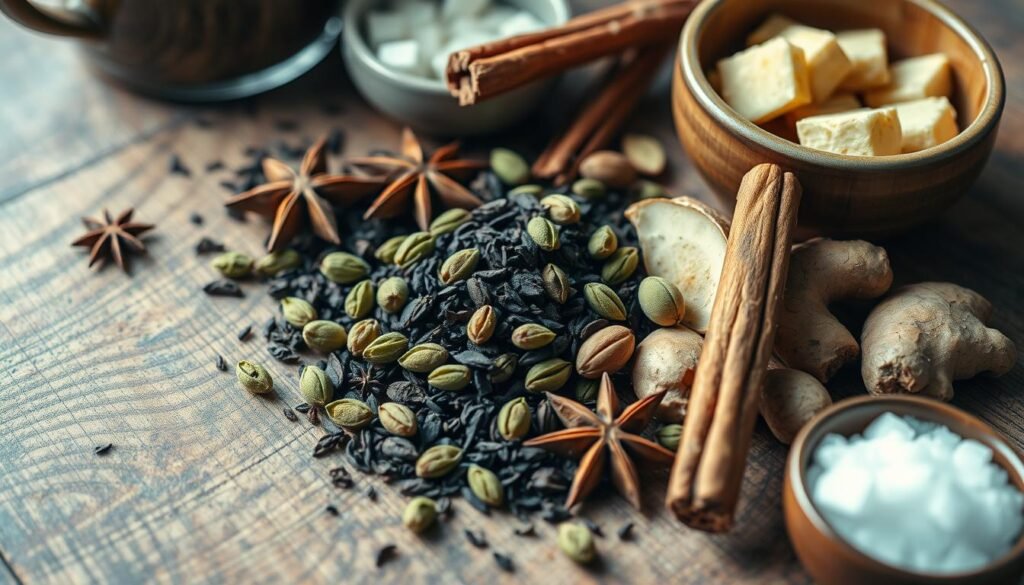
Making a true aromatic chai is all about the right mix of ingredients. It’s a journey to perfect the Chai latte. You start with the basic parts that make this drink unique.
The heart of a classic Masala Chai is built on four key elements:
- Black tea leaves (preferably Assam or Darjeeling)
- Whole spices
- Milk (dairy or plant-based)
- Sweetener
Now, let’s explore the world of spices that turn regular tea into a special drink. The usual spices are:
| Spice | Quantity | Flavor Profile |
|---|---|---|
| Green Cardamom Pods | 4 pods | Fragrant and slightly sweet |
| Whole Cloves | 2-3 cloves | Warm and intense |
| Cinnamon Stick | ½ to ¾ stick | Sweet and woody |
| Black Peppercorns | 2 (optional) | Spicy and sharp |
| Fresh Ginger | Small piece | Zesty and warming |
Want to try something new? Spices like star anise, nutmeg, or fennel can give your Chai latte a special touch. The trick is to find the right balance. Each spice should enhance the others, not take over.
Choosing your sweetener is also important. Jaggery or cane sugar are classic choices. But maple syrup or honey can add a modern twist to your chai.
The Art of Selecting Premium Tea Leaves
Choosing the right tea leaves is key to making great masala tea. The secret to a perfect chai is knowing about tea selection and how to prepare it.
CTC vs Loose Leaf: Navigating Your Tea Choices
When making masala chai, you’ll find two main tea types: CTC and loose leaf. CTC teas are small pieces that brew fast and pack a strong flavor. Loose leaf teas, on the other hand, give a more traditional taste.
- CTC: Faster brewing, robust flavor
- Loose Leaf: More nuanced, authentic taste
- Recommended ratio: 2 grams of tea leaves per cup
Regional Tea Varieties to Explore
India is home to many tea-growing areas, each with its own special taste. Assam teas are strong and malty, great for masala chai. Darjeeling teas are lighter and more delicate. Nilgiri teas add a smooth, aromatic touch to your chai.
Optimal Tea Storage Techniques
Keeping tea fresh is important. Store tea in airtight containers to keep it dry and flavorful. Each tea type has its own shelf life, so buy what you’ll use soon.
| Tea Type | Steep Time | Brewing Temperature |
|---|---|---|
| Black Tea | 2-5 minutes | 90-95°C |
| Masala Chai | 3-7 minutes | 90-95°C |
Choosing top-quality tea leaves makes your masala tea truly special. Try different teas and find your favorite blend!
Traditional Spice Blend Components
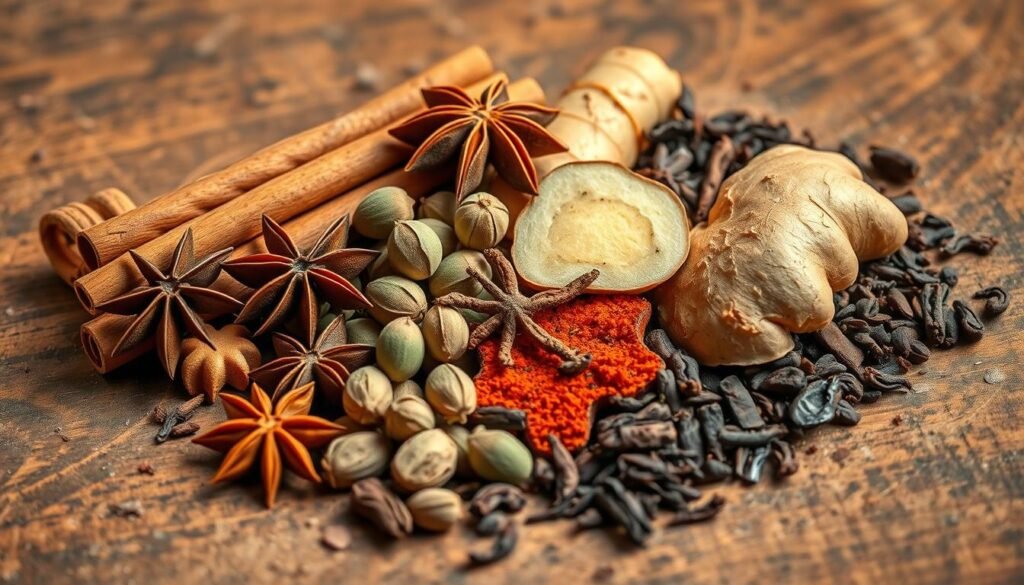
Making an authentic chai blend is like creating a work of art. It turns a simple drink into a feast for the senses. The secret is in the spices, which blend together in perfect harmony.
Now, let’s look at the main spices in a traditional masala chai:
- Green cardamom (primary flavor enhancer)
- Whole black peppercorns
- Ceylon cinnamon
- Whole cloves
- Fennel seeds
- Ground ginger
These spices form the base, but you can also try adding unique spices. Tulsi, nutmeg, or star anise can make your chai truly special.
| Spice | Quantity (per recipe) | Flavor Profile |
|---|---|---|
| Green Cardamom | 40g (¼ + ⅛ cup) | Aromatic, slightly sweet |
| Cinnamon | 20g (3 quills) | Warm, sweet undertones |
| Black Peppercorns | 20g (2 tablespoons) | Spicy, sharp kick |
| Whole Cloves | 20g (6-8 teaspoons) | Intense, pungent notes |
The magic of making chai is understanding how these spices work together. Each one adds its own flavor, making the drink complex and satisfying. It’s a drink that warms your heart and soul.
Mastering the Classic Masala Chai Brewing Technique
Making the perfect traditional chai tea is an art that has been passed down for generations. Our homemade chai recipe shares the secrets to making authentic masala chai. It captures the essence of Indian culinary tradition.
The secret to a great chai is in its brewing method. We’ll explore the techniques that turn simple ingredients into a rich, aromatic drink.
The Double Boil Method
Traditional chai uses a special double boil technique. It intensifies flavor and balances spices perfectly. Here’s how to do it:
- Use fresh whole spices like cardamom, cinnamon, and ginger
- Bring the water and spices to a first boil, releasing essential oils
- Add tea leaves and simmer for 2 minutes
- Bring to a second boil to enhance depth of flavor
Chaiwallah’s Pulling Technique
Street vendors in India use a pulling technique to aerate the chai. This creates a creamy texture. Here’s how it works:
- Scooping chai from a height using a ladle
- Pouring the liquid back into the pot dramatically
- Creating a frothy, well-mixed beverage
- Introducing oxygen to enhance flavor complexity
Temperature Control Tips
Controlling the temperature is key for a perfect homemade chai. Follow these tips:
- Keep water temperature between 195-205°F
- Avoid over-boiling to prevent bitterness
- Simmer spices for 5-7 minutes to develop full flavor
- Use a 1:1 ratio of water to milk for ideal creaminess
By using these traditional chai tea techniques, you’ll make your home brewing a true culinary experience. It honors centuries of Indian tea-making tradition.
The Role of Milk in Authentic Chai Preparation
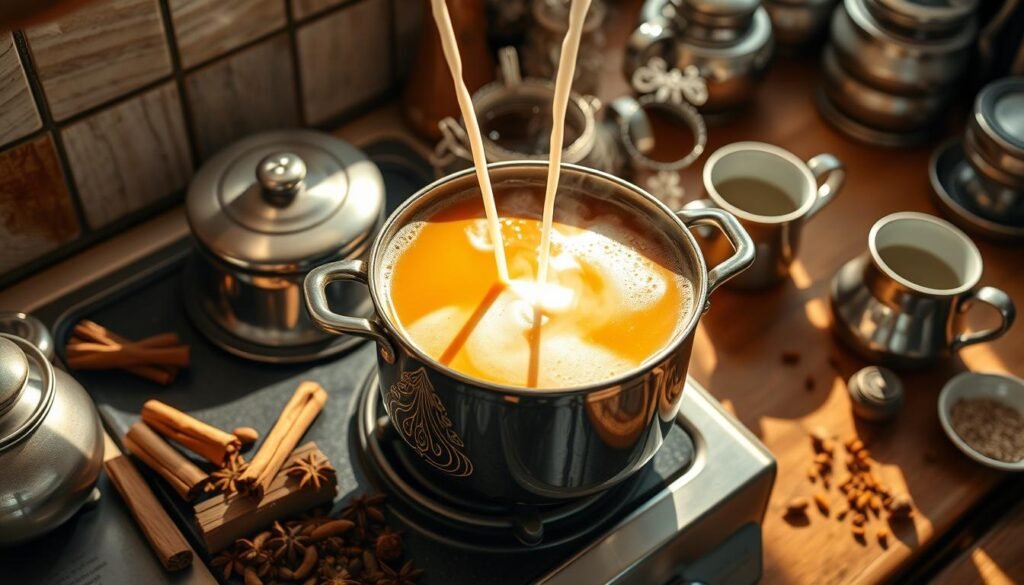
Milk turns Classic Masala Chai into a creamy, comforting drink. The right milk makes your Indian spiced tea extra special. It gives the tea that velvety texture everyone loves.
For real Masala Chai, whole milk is the best. Its fat helps bring out spice flavors and adds a luxurious layer on top. The mix of milk and water is 1:2, perfect for creaminess and flavor.
Milk Options for Every Preference
- Organic whole milk (traditional choice)
- Oat milk (top vegan alternative)
- Cashew milk
- Almond milk
- Soy milk
If you don’t like dairy, plant-based milks are great. Oat milk is especially good because it’s closest to whole milk. It’s perfect for your Classic Masala Chai.
| Milk Type | Calories per 8 oz | Fat Content |
|---|---|---|
| Whole Milk | 162 | 5g |
| Oat Milk | 120 | 3g |
| Almond Milk | 60 | 2.5g |
Perfect Indian spiced tea comes from trying different milks. Whether it’s traditional whole milk or a plant-based option, the right milk changes your Masala Chai experience.
Sweetener Options and Their Impact on Flavor
Sweetening your chai latte is more than just adding sugar. It’s an art that can make your masala tea truly special. The right sweetener can bring out the best in your favorite spiced drink.
Traditional Sweetening Techniques
In India, jaggery is the go-to sweetener for chai. This unrefined cane sugar has a unique flavor that pairs well with spices. It balances the strong spices like cardamom and ginger perfectly.
Modern Sweetener Alternatives
Today, you have many sweetener options:
- Raw brown sugar
- Demerara sugar
- Honey
- Maple syrup
- Organic cane sugar
Balancing Sweetness and Spice
Here are some tips for sweetening your masala tea:
- Start with a small amount of sweetener
- Adjust to taste
- Spices can change how sweet it tastes
- Keep trying until you find your favorite mix
Pro tip: Stay away from artificial sweeteners. They can mess up the real taste of your chai latte. Natural sweeteners like honey or maple syrup are better because they enhance the spices that make chai so loved.
Serving and Pairing Suggestions
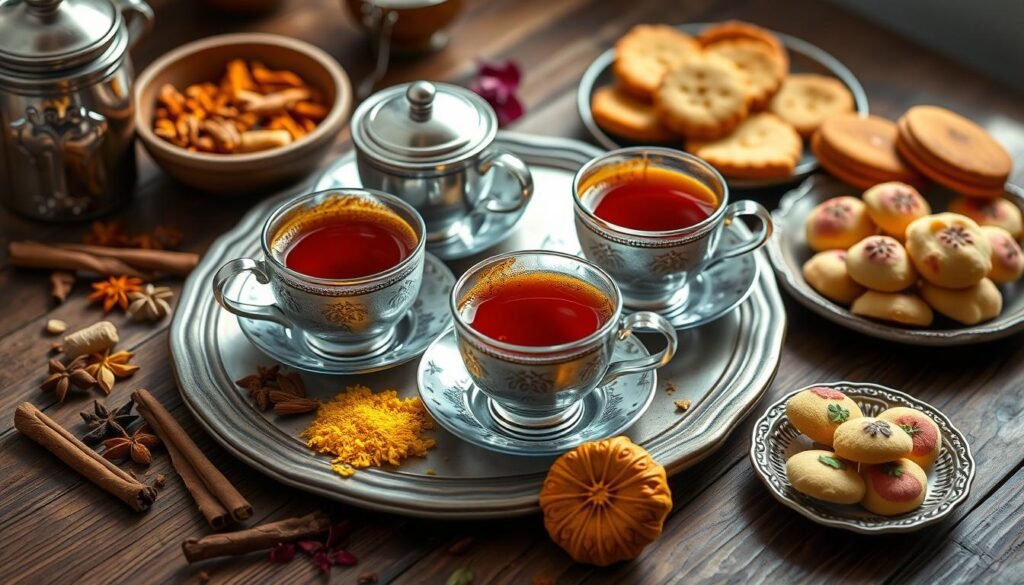
Turning your aromatic chai into a special experience is more than just brewing. It’s about choosing the right things to go with it. These choices can make your chai time truly unforgettable.
In India, chai time is filled with delicious pairings that match the chai’s rich flavors. Let’s look at some classic combinations that will make your chai time special.
Classic Chai Companions
- Parle-G Biscuits: The perfect dunking friend that gets soft in chai
- Samosas: Spicy potato-filled pastries that balance the tea’s strong taste
- Pakoras: Crispy vegetable fritters that add a nice texture contrast
- Mathri: Flaky, spiced crackers that offer a savory contrast
- Jalebi: Sweet, deep-fried treats that warm up the chai
Different places in India have their own favorite pairings. In the North, people enjoy spicy chutneys with their chai. In the South, they might prefer lighter snacks like roasted chickpeas.
Modern Pairing Innovations
- Milk chocolate for a smooth flavor balance
- Spiced cookies with ginger or clove undertones
- Cheese and crackers for a sophisticated twist
Chai is more than a drink; it’s a way to connect with others. Whether you’re alone or with friends, these pairings will make your chai experience unforgettable.
Health Benefits and Wellness Properties
Traditional chai tea is more than just tasty. It’s a wellness powerhouse, packed with health benefits that boost your overall well-being.
Antioxidant Powerhouse
The black tea in Classic Masala Chai is full of antioxidants. These antioxidants fight free radicals, which can prevent cell damage and lower disease risks.
- Reduces free radical damage
- Supports cellular health
- May prevent certain cancer developments
Digestive Support
Spices like ginger and cardamom in traditional chai tea support your digestive health. They improve circulation, nutrient absorption, and soothe digestive issues.
Immune System Enhancement
| Ingredient | Immune Benefits |
|---|---|
| Ginger | Antibacterial properties, boosts immunity |
| Cardamom | High vitamin C content, supports immune health |
| Cinnamon | Anti-inflammatory, potential cognitive benefits |
Every sip of Classic Masala Chai strengthens your immune system. It may help lower the risk of common illnesses.
Energy and Mental Clarity
The black tea in Classic Masala Chai gives a gentle energy boost. With chai spices, it improves focus and mental alertness without the jitters.
Seasonal Adaptations for Year-Round Enjoyment
Making the perfect homemade chai recipe is more than just a formula. It’s about matching the tea to each season. In India, people adjust their spiced tea to fit the weather. Whether it’s cold winter mornings or hot summer afternoons, Masala Chai adapts to keep you cozy and happy.
Spice blends change with the seasons. In winter, a strong chai with more ginger and cinnamon warms you up. Traditional tea making calls for more black pepper and cardamom to keep you warm.
In summer, a lighter iced chai is perfect. Use less milk and add mint for a refreshing twist. With over 100,000 tea estates in India, you can always find new flavors to try. Visit www.recipekeepers.com for more seasonal ideas!
